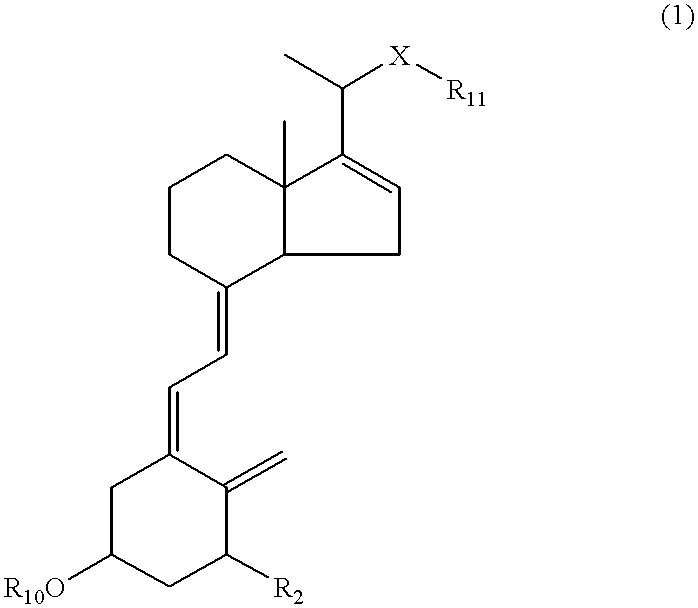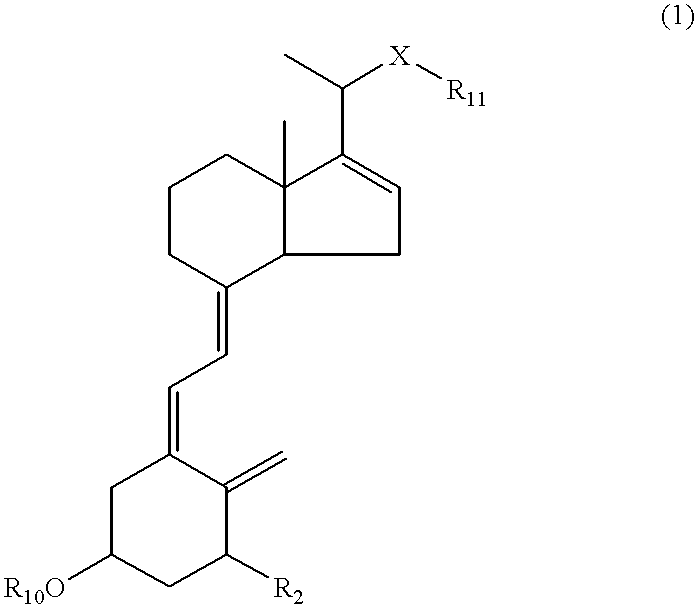16-ene-vitamin D derivatives
a technology of ene-vitamin d and derivatives, applied in the field of 16ene-vitamin d derivatives, can solve the problems of weak hypercalcemic activity, weak hypercalcemic activity, and strong hypercalcemic activity of none of these compounds, and achieve the effect of high binding ability
- Summary
- Abstract
- Description
- Claims
- Application Information
AI Technical Summary
Benefits of technology
Problems solved by technology
Method used
Image
Examples
example 1
Preparation of 1.alpha.,3.beta.-bis(tert-butyldimethylsilyloxy)-20(S)-phenoxycarbonylthiopregna-5,7,16-triene
To a solution of 1.alpha.,3.beta.-bis(tert-butyldimethyl-silyloxy)-16.alpha.-hydroxypregna-5,7,17(E)-triene (150 mg, 0.27 mmol) in dichloromethane (5 ml) were added pyridine (0.13 ml, 1.61 mmol) and phenyl chlorothionoformate (0.11 ml, 0.81 mmol), and the mixed solution was stirred at room temperature for one hour and then concentrated under reduced pressure. The residue was diluted with hexane and washed with ice-cooled 1N hydrochloric acid, saturated aqueous sodium bicarbonate solution and brine successively, and the organic layer was dried over magnesium sulfate. The solvent was removed under reduced pressure, and the resulting residue was purified by preparative thin layer chromatography (0.5 mm.times.4, hexane:ethyl acetate=9:1, developed once) to give the title compound as a colorless solid (160 mg, 85%).
IR(KBr): 2920, 2850, 1720, 1490, 1460, 1370, 1245, 1180, 1155, 109...
example 2
Preparation of 1.alpha.-(tert-butyldimethylsilyloxy)-3.beta.-hydroxy-20(S)-phenoxycarbonylthiopregna-5.7,16-triene
In the same manner as in Example 1, 1.alpha.,3.beta.-bis(tert-butyldimethylsilyloxy)-16.alpha.-hydroxypregna-5,7,17(E)-triene (1.50 g, 2.68 mmol), pyridine (1.30 ml, 16.1 mmol) and phenyl thionochloroformate (1.11 ml, 8.04 mmol) were reacted in dichloromethane (50 ml) and worked up, then the residue was dissolved in tetrahydrofuran (50 ml) without purification and stirred with Amberlyst 15 (3.00 g) at room temperature for 36 hours. The resin was filtered and washed with tetrahydrofuran, then the filtrate was concentrated under reduced pressure and the residue was purified by column chromatography (hexane:ethyl acetate=7:1.fwdarw.5:1) to give the title compound as a colorless oil (1.07 g, 69%).
IR(neat): 3250, 2920, 2850, 1720, 1490, 1460, 1370, 1260, 1190, 1165, 1100 cm.sup.-1. .sup.1 H NMR .delta.: 0.08(s, 3H), 0.12(s, 3H), 0.88(s, 9H), 0.95(s, 3H), 0.96(s, 3H), 1.60(d, ...
example 3
Preparation of 1.alpha.-(tert-butyldimethylsilyloxy)-3.beta.hydroxy-20(S)-(3-hydroxy-3-methylbutylthio)pregna-5,7,16-triene
To a solution of 1.alpha.-(tert-butyldimethylsilyloxy)-3.beta.-hydroxy-20(S)-phenoxycarbonylthiopregna-5,7,16-triene (81.6 mg, 0.140 mmol) and 4-bromo-2-methyl-2-butanol (117 mg, 0.700 mmol) in tetrahydrofuran (1 ml) was added 1M KOH solution in methanol (1 ml), and the mixed solution was stirred at room temperature for 30 minutes, then concentrated under reduced pressure. The residue was diluted with hexane, washed with brine and dried over magnesium sulfate, and then the solvent was distilled off under reduced pressure. The resulting residue was purified by preparative thin layer chromatography (0.5 mm.times.2, dichloromethane:ethyl acetate=8:1, developed once) to give the title compound as a colorless oil (60.3 mg, 79%).
IR(neat): 3400, 2950, 2850, 1460, 1370, 1250, 1200, 1150, 1060 cm.sup.-1. .sup.1 H NMR .delta.: 0.08(s, 3H), 0.13(s, 3H), 0.88(s, 9H), 0.93(s...
PUM
 Login to View More
Login to View More Abstract
Description
Claims
Application Information
 Login to View More
Login to View More - R&D
- Intellectual Property
- Life Sciences
- Materials
- Tech Scout
- Unparalleled Data Quality
- Higher Quality Content
- 60% Fewer Hallucinations
Browse by: Latest US Patents, China's latest patents, Technical Efficacy Thesaurus, Application Domain, Technology Topic, Popular Technical Reports.
© 2025 PatSnap. All rights reserved.Legal|Privacy policy|Modern Slavery Act Transparency Statement|Sitemap|About US| Contact US: help@patsnap.com



